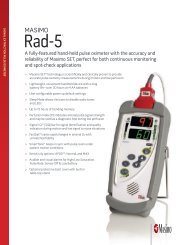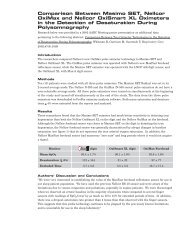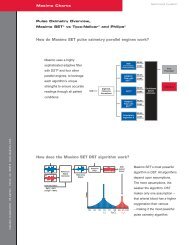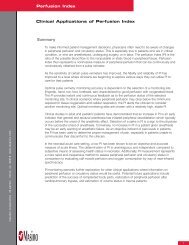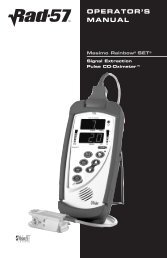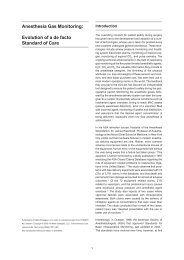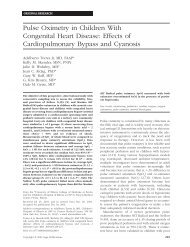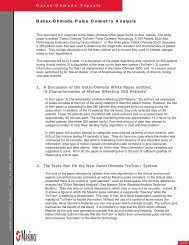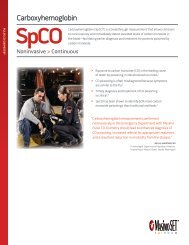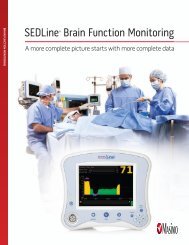Detecting Carbon Monoxide Poisoning in the Emergency ... - Masimo
Detecting Carbon Monoxide Poisoning in the Emergency ... - Masimo
Detecting Carbon Monoxide Poisoning in the Emergency ... - Masimo
You also want an ePaper? Increase the reach of your titles
YUMPU automatically turns print PDFs into web optimized ePapers that Google loves.
Demystify<strong>in</strong>g Carboxyhemoglob<strong>in</strong>emia - ED<br />
<strong>Detect<strong>in</strong>g</strong> <strong>Carbon</strong> <strong>Monoxide</strong> <strong>Poison<strong>in</strong>g</strong><br />
<strong>in</strong> <strong>the</strong> <strong>Emergency</strong> Department<br />
Summary<br />
<strong>Carbon</strong> <strong>Monoxide</strong> (CO) is a gas produced by <strong>the</strong> combustion of carbon-conta<strong>in</strong><strong>in</strong>g fuels or <strong>the</strong><br />
<strong>in</strong>adequate ventilation of natural gas. Once <strong>in</strong> <strong>the</strong> bloodstream, CO prevents oxygen from reach<strong>in</strong>g<br />
tissues. Undetectable by humans, exposure to CO is <strong>the</strong> lead<strong>in</strong>g cause of death by poison<strong>in</strong>g <strong>in</strong><br />
<strong>in</strong>dustrialized countries. Still, <strong>the</strong> condition presents a constellation of symptoms that mimic o<strong>the</strong>r<br />
illnesses. As a result as many as half of all CO-poisoned patients may be misdiagnosed when<br />
present<strong>in</strong>g to emergency departments, delay<strong>in</strong>g treatment and even return<strong>in</strong>g vulnerable patients<br />
and <strong>the</strong>ir families to potentially lethal environments.<br />
CO exposure may be detected by measur<strong>in</strong>g <strong>the</strong> carboxyhemoglob<strong>in</strong> (COHb) levels <strong>in</strong> a person’s<br />
blood. In hospitals, <strong>the</strong> most common means of measur<strong>in</strong>g COHb is through <strong>the</strong> analysis of<br />
an <strong>in</strong>vasive blood sample us<strong>in</strong>g a laboratory CO-Oximeter. However, accord<strong>in</strong>g to one recently<br />
published study, only about half of all hospitals have <strong>the</strong> devices onsite. For hospitals with a CO-<br />
Oximeter, results may be obta<strong>in</strong>ed <strong>in</strong> about 10 m<strong>in</strong>utes but <strong>in</strong> hospitals that must send <strong>the</strong> samples<br />
elsewhere for test<strong>in</strong>g, results require an average of 15 hours. Each additional read<strong>in</strong>g requires<br />
ano<strong>the</strong>r blood draw and analysis. Conventional pulse oximeters are unable to detect COHb but<br />
a new device, <strong>the</strong> <strong>Masimo</strong> SET with Ra<strong>in</strong>bow Technology monitor allows cl<strong>in</strong>icians to detect and<br />
cont<strong>in</strong>uously monitor CO levels <strong>in</strong> <strong>the</strong> bloodstream non<strong>in</strong>vasively. Us<strong>in</strong>g multiple wavelengths of<br />
light to dist<strong>in</strong>guish <strong>the</strong> various forms of hemoglob<strong>in</strong> (oxy-, deoxy-, carboxy- and met-) <strong>the</strong> device is<br />
capable of measur<strong>in</strong>g blood CO saturation (SpCO ® ) levels and me<strong>the</strong>moglob<strong>in</strong> saturation (SpMet TM )<br />
levels, <strong>in</strong> addition to <strong>the</strong> conventional variables of pulse rate, perfusion <strong>in</strong>dex and arterial oxygen<br />
saturation.<br />
masimo corporation 40 parker irv<strong>in</strong>e ca 92618 www.masimo.com<br />
The stakes for properly diagnos<strong>in</strong>g and treat<strong>in</strong>g CO poison<strong>in</strong>g are high. Assessment of a patient’s<br />
COHb level first provides an accurate diagnosis of CO poison<strong>in</strong>g and <strong>the</strong>n guides treatment<br />
especially <strong>in</strong> cases elevated to <strong>the</strong> range of 10 percent or greater. Some mistakenly believe that if<br />
a patient recovers from <strong>the</strong> <strong>in</strong>itial CO poison<strong>in</strong>g, <strong>the</strong>y have made a complete recovery. However,<br />
multiple studies show that patients with prolonged and untreated CO exposure have long-term<br />
side effects and <strong>in</strong>creased risk. If untreated, CO exposure may damage <strong>the</strong> neurological, cardiac,<br />
metabolic, pulmonary and renal systems of <strong>the</strong> body. Organs with a high metabolic requirement<br />
for oxygen, such as <strong>the</strong> heart and bra<strong>in</strong>, are most susceptible to <strong>in</strong>jury from CO. Even at relatively<br />
low COHb levels, patients with underly<strong>in</strong>g cardiovascular disease are especially at serious risk for<br />
cardiac complications <strong>in</strong>clud<strong>in</strong>g myocardial ischemia or <strong>in</strong>farction, and even cardiac arrest.<br />
Fortunately, <strong>the</strong> effects of CO poison<strong>in</strong>g can be reversed if caught <strong>in</strong> time. The immediacy of<br />
results and ability to trend <strong>the</strong> results over time expedite efficacious treatment and may contribute<br />
to improved cl<strong>in</strong>ical outcomes. With lives and significant resources at stake, <strong>the</strong> speed at which<br />
suspicion evolves to diagnosis is critical. A quick non<strong>in</strong>vasive measurement of COHb us<strong>in</strong>g a new<br />
Ra<strong>in</strong>bow Pulse CO-Oximeter TM device may contribute to better <strong>in</strong>formed treatment decisions.<br />
1
Demystify<strong>in</strong>g Carboxyhemoglob<strong>in</strong>emia - ED<br />
The Guess<strong>in</strong>g Game<br />
CO poison<strong>in</strong>g is <strong>the</strong> lead<strong>in</strong>g cause of death by poison<strong>in</strong>g <strong>in</strong> <strong>in</strong>dustrialized countries 1 and may be<br />
responsible for more than half of all fatal poison<strong>in</strong>gs worldwide. 2 It is estimated that approximately<br />
43,000 emergency room visits are attributed to CO poison<strong>in</strong>g <strong>in</strong> <strong>the</strong> United States each year. 3 At<br />
least 3,800 people die annually <strong>in</strong> <strong>the</strong> U.S. from <strong>the</strong> effects of CO poison<strong>in</strong>g, and 1,400 of <strong>the</strong>se<br />
deaths are accidental. 4-5 Unfortunately, for most patients poisoned by <strong>the</strong> colorless, odorless,<br />
tasteless gas, CO poison<strong>in</strong>g is not <strong>the</strong> immediate and obvious diagnosis. Variable symptoms, a<br />
wide range of patient sensitivity and unsophisticated detection systems often result <strong>in</strong> misdiagnosis<br />
and treatment delays.<br />
Rapid Determ<strong>in</strong>ation of <strong>Carbon</strong> <strong>Monoxide</strong> <strong>Poison<strong>in</strong>g</strong> (COHb)<br />
• <strong>Emergency</strong> Departments • Acute Care Hospitals<br />
• Urgent Care Facilities<br />
• Physicians Offices<br />
• Inpatient / Outpatient Surgery Centers<br />
• First – Responders/ <strong>Emergency</strong> Medical<br />
Services and Fire / Homeland Security<br />
• Po<strong>in</strong>t of Care – Natural Disaster Zones<br />
• Toll Booths / Park<strong>in</strong>g Garages<br />
• Airplanes<br />
• Construction zone<br />
Even <strong>in</strong> <strong>the</strong> case of Randal McCloy, <strong>the</strong> sole survivor of <strong>the</strong> Sago M<strong>in</strong>e tragedy, <strong>in</strong> which CO<br />
poison<strong>in</strong>g was <strong>the</strong> probable cause of illness (accord<strong>in</strong>g to multiple published accounts of <strong>the</strong><br />
<strong>in</strong>cident), <strong>the</strong> first physician to attend to <strong>the</strong> m<strong>in</strong>er reported that McCloy's carbon monoxide levels<br />
were negative. “That means that as best as we can tell with somewhat primitive equipment that we<br />
have here for measur<strong>in</strong>g those, his carboxyhemoglob<strong>in</strong> levels were negative, <strong>in</strong>dicat<strong>in</strong>g no carbon<br />
monoxide <strong>in</strong> his system, as far as we could tell,” she told reporters.<br />
masimo corporation 40 parker irv<strong>in</strong>e ca 92618 www.masimo.com<br />
When pressed for more <strong>in</strong>formation, <strong>the</strong> cl<strong>in</strong>ician told <strong>the</strong> media, “When you put <strong>the</strong> oxygen<br />
saturation monitor on <strong>the</strong>ir f<strong>in</strong>ger, it's false [but] it doesn't give you a true read<strong>in</strong>g <strong>in</strong> somebody<br />
with carbon monoxide poison<strong>in</strong>g. So you really have to be able to run <strong>the</strong> blood and check for<br />
carboxyhemoglob<strong>in</strong>.” In fact, tests run <strong>in</strong> <strong>the</strong> subsequent days show McCloy to be suffer<strong>in</strong>g from<br />
bra<strong>in</strong> hemorrhag<strong>in</strong>g and edema, muscle <strong>in</strong>jury, liver failure and faulty heart function due to severe<br />
CO poison<strong>in</strong>g.<br />
Later, physicians at Allegheny General Hospital stated that after receiv<strong>in</strong>g three hyperbaric oxygen<br />
(HBO) treatments, McCloy was show<strong>in</strong>g signs of improved bra<strong>in</strong> stem and organ function. MRI<br />
scans illustrated <strong>the</strong> evidence of neurological damage but <strong>the</strong> cl<strong>in</strong>ical consequences rema<strong>in</strong> to<br />
be seen.<br />
Some people are more susceptible to longterm<br />
harm from CO exposure than o<strong>the</strong>rs. It is<br />
possible that <strong>the</strong> same physiology that enabled<br />
McCloy to survive generally lethal CO levels for<br />
more than forty hours may also afford him a<br />
better cl<strong>in</strong>ical outcome than would be expected.<br />
While <strong>the</strong>re are populations known to be highly<br />
susceptible to <strong>the</strong> negative effects of CO:<br />
children, pregnant women, adults with cardiac<br />
disease, <strong>in</strong>dividuals with <strong>in</strong>creased oxygen<br />
demand and patients with chronic respiratory<br />
problems; it is not possible to assess a person’s<br />
CO resilience.<br />
Elevated COHb: Patients at<br />
High Risk for Negative Outcome<br />
• Children; elderly<br />
• Adults with cardiac disease;<br />
• Pregnant women<br />
• Patients with <strong>in</strong>creased oxygen demand or<br />
decreased oxygen-carry<strong>in</strong>g capacity;<br />
• Patients with chronic respiratory <strong>in</strong>sufficiency.
whitepaper<br />
Symptoms<br />
CO poison<strong>in</strong>g is <strong>the</strong> s<strong>in</strong>gle most common source of poison<strong>in</strong>g <strong>in</strong>jury as treated <strong>in</strong> hospital emergency<br />
departments. While its presentation is not uncommon, <strong>the</strong> constellation of symptoms that manifest when a patient<br />
is poisoned with carbon monoxide do not prompt most cl<strong>in</strong>icians to consider carboxyhemoglob<strong>in</strong>emia when<br />
attempt<strong>in</strong>g a diagnosis. The vague symptoms can be mistaken for those of many o<strong>the</strong>r illnesses <strong>in</strong>clud<strong>in</strong>g food<br />
poison<strong>in</strong>g, <strong>in</strong>fluenza, migra<strong>in</strong>e headache, or substance abuse. In <strong>the</strong> attempt to f<strong>in</strong>d <strong>the</strong> causative agent for <strong>the</strong><br />
symptoms, many unnecessary, potentially costly and sometime resource-<strong>in</strong>tensive diagnostics may be ordered, to<br />
no avail. Because <strong>the</strong> symptoms of CO poison<strong>in</strong>g may mimic an <strong>in</strong>tracranial bleed, time and cost for a negative<br />
result may precede proper diagnosis, unnecessarily <strong>in</strong>creas<strong>in</strong>g healthcare costs. Dur<strong>in</strong>g <strong>the</strong> delay associated with<br />
runn<strong>in</strong>g unnecessary diagnostics, patients may f<strong>in</strong>d that <strong>the</strong>ir symptoms abate and <strong>the</strong>ir health improves as <strong>the</strong><br />
hidden culprit, CO, is flushed from <strong>the</strong> blood dur<strong>in</strong>g <strong>the</strong> normal ventilation patterns over time. Multiple reports have<br />
shown that <strong>the</strong> patients may be discharged and returned back to <strong>the</strong> environment where <strong>the</strong> poison<strong>in</strong>g occurred,<br />
only to once aga<strong>in</strong> be exposed to <strong>the</strong> silent killer, carbon monoxide.<br />
There are two ma<strong>in</strong> types of CO poison<strong>in</strong>g: acute, which is caused by short exposure to a high level of carbon<br />
monoxide, and chronic or subacute, which results from long exposure to a low level of CO. Which symptoms<br />
appear depend on <strong>the</strong> level of CO <strong>in</strong> <strong>the</strong> environment and <strong>the</strong> length of exposure, as well as <strong>the</strong> patient’s state<br />
of health.<br />
The general symptoms of CO poison<strong>in</strong>g, <strong>in</strong>clud<strong>in</strong>g headache, dizz<strong>in</strong>ess, nausea, fatigue, and weakness, are<br />
vague. See Table 1. Patients with acute CO poison<strong>in</strong>g are more likely to present with more serious symptoms,<br />
such as cardiopulmonary problems, confusion, syncope, coma, and seizure. Chronic poison<strong>in</strong>g is generally<br />
associated with <strong>the</strong> less severe symptoms. 14 Low-level exposure can exacerbate ang<strong>in</strong>a and chronic obstructive<br />
pulmonary disease, and patients with coronary artery disease are at risk for ischemia and myocardial <strong>in</strong>farction<br />
even at low levels of CO. 15-16<br />
Patients that present with low COHb levels correlate well with mild symptoms described <strong>in</strong> Table 2 as do cases<br />
that register levels of 50-70%, 17 which are generally fatal. However, <strong>in</strong>termediate levels show little correlation with<br />
symptoms or with prognosis. It seems that <strong>the</strong> severity of cl<strong>in</strong>ical condition is not only related to CO concentration<br />
but also <strong>the</strong> duration of exposure and <strong>the</strong> prevail<strong>in</strong>g cl<strong>in</strong>ical disposition of <strong>the</strong> patient. Some patients present<strong>in</strong>g<br />
with a carboxyhemoglob<strong>in</strong> level of 20% may be remarkably symptomatic, while o<strong>the</strong>rs experienc<strong>in</strong>g <strong>the</strong> same level<br />
of COHb% may exhibit only mild, equivocal symptoms. A patient exposed to high concentrations for a short time<br />
may be less symptomatic than a patient who reaches <strong>the</strong> same COHb level after a prolonged exposure.<br />
Table 1: Cl<strong>in</strong>ical Signs & Symptoms associated with CO<br />
<strong>Poison<strong>in</strong>g</strong> and correlated COHb levels 18-19<br />
Severity COHb Level Signs & Symptoms<br />
Mild
Demystify<strong>in</strong>g Carboxyhemoglob<strong>in</strong>emia - ED<br />
Detection<br />
Table 2: COHb Levels <strong>in</strong> Persons 3 - 74 Years of Age 20<br />
Smok<strong>in</strong>g Status<br />
Percent COHb<br />
(mean + SD)<br />
Percent COHb<br />
(98th percentile)<br />
Nonsmokers 0.83 + 0.67 < 2.50<br />
Current smokers 4.30 + 2.55 < 10.00<br />
All statuses comb<strong>in</strong>ed 1.94 + 2.24 < 9.00<br />
One th<strong>in</strong>g that is certa<strong>in</strong> about COHb levels is that smokers present with higher levels than do<br />
non-smokers. As can be seen <strong>in</strong> Table 2, 20 <strong>the</strong> COHb level <strong>in</strong> non-smokers is approximately one to<br />
two percent. In patients who smoke, a basel<strong>in</strong>e level of nearly five percent is considered normal,<br />
although it can be as high as 13 percent. Although COHb concentrations between 11 percent and<br />
30 percent can produce symptoms, it is important to consider <strong>the</strong> patient’s smok<strong>in</strong>g status.<br />
CO poison<strong>in</strong>g is known as <strong>the</strong> great imitator for its ability to present with equivocal signs and<br />
symptoms, many of which closely resemble o<strong>the</strong>r diseases. In particular, patients may be<br />
misdiagnosed with viral illness, acute myocardial <strong>in</strong>farction, and migra<strong>in</strong>e. It is estimated that CO<br />
poison<strong>in</strong>g misdiagnosis may occur <strong>in</strong> up to 30-50 percent of CO-exposed patients present<strong>in</strong>g to<br />
emergency departments. 21-23 As described below, fail<strong>in</strong>g to assess COHb levels early may return<br />
vulnerable patients and <strong>the</strong>ir families to potentially lethal environments.<br />
Miss<strong>in</strong>g <strong>the</strong> Signs<br />
masimo corporation 40 parker irv<strong>in</strong>e ca 92618 www.masimo.com<br />
A 67-year-old man sought medical help after three days of light-headedness, vertigo, stabb<strong>in</strong>g chest<br />
pa<strong>in</strong>, cough, chills and headache. His wife had experienced similar ailments over <strong>the</strong> past week.<br />
He was admitted, evaluated and discharged with a diagnosis of viral syndrome. Ten days later he<br />
returned to <strong>the</strong> ER with vertigo, palpitations and nausea but was sent home for outpatient followup.<br />
Four days later he aga<strong>in</strong> returned to <strong>the</strong> ER with diarrhea and severe chest pa<strong>in</strong>, collaps<strong>in</strong>g to<br />
<strong>the</strong> floor. He was admitted to <strong>the</strong> Coronary Care Unit with acute myocardial <strong>in</strong>farction. Among <strong>the</strong><br />
results of a rout<strong>in</strong>e arterial blood gas analysis, it was found that his COHb levels were 15.6%. A<br />
COHb level <strong>the</strong>n obta<strong>in</strong>ed on his wife was 18.1%. A rusted furnace was found to be <strong>the</strong> source. 15<br />
A 69-year-old man came to <strong>the</strong> ER after days of confusion, nausea, vomit<strong>in</strong>g, <strong>in</strong>termittent syncope,<br />
halluc<strong>in</strong>ations and shortness of breath. An arterial blood gas measurement found an oxygen<br />
saturation of 89%. He was admitted to <strong>the</strong> coronary care unit with a diagnosis of acute myocardial<br />
<strong>in</strong>farction. The next day a COHb level was measured and normal. While <strong>the</strong> patient was hospitalized<br />
he <strong>in</strong>vited his sister and daughter-<strong>in</strong>-law to stay <strong>in</strong> his home. They both arrived at <strong>the</strong> ER <strong>the</strong> next<br />
morn<strong>in</strong>g with headaches, vomit<strong>in</strong>g, and vertigo. Their COHb levels on <strong>in</strong>itial observation were 28%<br />
and 32%. The man’s gas water heater was faulty. 15<br />
A 47-year-old male urologist and his wife attended a medical conference <strong>in</strong> Jackson, Wyom<strong>in</strong>g.<br />
Both reported to a local emergency department with symptoms <strong>in</strong>clud<strong>in</strong>g headache, malaise, and<br />
metabolic acidosis. The husband and wife were sent back to <strong>the</strong> conference resort hotel with a<br />
diagnosis of gastroenteritis. The follow<strong>in</strong>g day, <strong>the</strong>y were both found unresponsive <strong>in</strong> <strong>the</strong>ir hotel. He<br />
died 3 hours later, and his wife has severe long-term neurocognitive sequelae. The cause of death<br />
and long-term morbidity was carbon monoxide poison<strong>in</strong>g due to a faulty boiler. A $17,000,000<br />
verdict was awarded to <strong>the</strong> afflicted family aga<strong>in</strong>st <strong>the</strong> resort hotel owners.
whitepaper<br />
Regardless of <strong>the</strong> means of detection used <strong>in</strong> emergency department care, several factors make assess<strong>in</strong>g <strong>the</strong><br />
severity of <strong>the</strong> CO poison<strong>in</strong>g difficult. The length of time s<strong>in</strong>ce CO exposure is one such factor. The half-life of CO<br />
is four to six hours when <strong>the</strong> patient is breath<strong>in</strong>g room air, and 40–60 m<strong>in</strong>utes when <strong>the</strong> patient is breath<strong>in</strong>g 100<br />
percent oxygen. If a patient is given oxygen dur<strong>in</strong>g <strong>the</strong>ir transport to <strong>the</strong> emergency department, it will be difficult<br />
to know when <strong>the</strong> COHb level peaked. 15<br />
In addition, COHb levels may not fully correlate with <strong>the</strong> cl<strong>in</strong>ical condition of CO-poisoned patients because <strong>the</strong><br />
COHb level <strong>in</strong> <strong>the</strong> blood is not an absolute <strong>in</strong>dex of compromised oxygen delivery at <strong>the</strong> tissue level. Fur<strong>the</strong>rmore,<br />
levels may not match up to specific signs and symptoms; patients with moderate levels will not necessarily appear<br />
sicker than patients with lower levels. 31<br />
In hospitals, <strong>the</strong> most common means of measur<strong>in</strong>g CO exposure is through <strong>the</strong> use of a laboratory CO-Oximeter.<br />
A blood sample, under a physician order, is drawn from ei<strong>the</strong>r venous or arterial vessel and <strong>in</strong>jected <strong>in</strong>to a lab CO-<br />
Oximeter. The laboratory device measures <strong>the</strong> <strong>in</strong>vasive blood sample us<strong>in</strong>g a method called spectrophotometric<br />
blood gas analysis. 24 Because <strong>the</strong> CO-Oximeter can only yield a s<strong>in</strong>gle, discrete read<strong>in</strong>g for each aliquot of blood<br />
sampled, <strong>the</strong> reported value is a noncont<strong>in</strong>uous snapshot of <strong>the</strong> patient’s condition at <strong>the</strong> particular moment that<br />
<strong>the</strong> sample was collected. To compound <strong>the</strong> difficulty of detect<strong>in</strong>g CO exposure, when <strong>the</strong> laboratory calculates<br />
<strong>the</strong> patient’s oxygen saturation levels from <strong>the</strong> oxygen partial pressure (PO 2 ), <strong>the</strong> arterial SaO 2 may appear normal.<br />
The cl<strong>in</strong>ical usefulness of CO-Oximetry is <strong>in</strong>hibited fur<strong>the</strong>r by <strong>the</strong> relative deficiency of devices currently <strong>in</strong>stalled<br />
<strong>in</strong> acute care hospitals. One recent study found that fewer than half of hospitals <strong>in</strong> <strong>the</strong> U.S. have <strong>the</strong> necessary<br />
equipment on site to diagnose CO poison<strong>in</strong>g. 25 For those that did not have <strong>the</strong> test<strong>in</strong>g equipment, <strong>the</strong> average time<br />
to receive results of a blood sample sent to ano<strong>the</strong>r facility was over 15 hours. In hospitals that have CO-Oximetry<br />
equipment, results may be returned <strong>in</strong> an average of 10 m<strong>in</strong>utes (see Table 4.)<br />
Unfortunately, standard pulse oximeters are <strong>in</strong>capable of isolat<strong>in</strong>g <strong>the</strong> carbon monoxide contam<strong>in</strong>ated hemoglob<strong>in</strong><br />
from <strong>the</strong> oxyhemoglob<strong>in</strong>. 26 Thus, pulse oximeters artificially overestimate arterial oxygen saturation <strong>in</strong> <strong>the</strong> presence<br />
of elevated blood carbon monoxide. Therefore, <strong>the</strong> read<strong>in</strong>gs will be falsely high when carbon monoxide is<br />
occupy<strong>in</strong>g b<strong>in</strong>d<strong>in</strong>g sites on <strong>the</strong> heme molecule.<br />
Table 3: Comparison of Test<strong>in</strong>g Methods Time to Results 25<br />
Test<strong>in</strong>g Method<br />
Pulse CO-Oximeter<br />
Onsite CO-Oximeter<br />
Off-Site CO-Oximeter<br />
Average Time to Result<br />
Seconds<br />
10 M<strong>in</strong>utes<br />
15 Hours<br />
The latest technology <strong>in</strong> CO poison<strong>in</strong>g detection employs a non<strong>in</strong>vasive and cont<strong>in</strong>uous platform. The <strong>Masimo</strong><br />
SET ® with Ra<strong>in</strong>bow Technology Pulse CO-Oximeter Monitor [<strong>Masimo</strong>, Irv<strong>in</strong>e, CA] is <strong>the</strong> first device that allows<br />
cl<strong>in</strong>icians to detect and cont<strong>in</strong>uously monitor CO levels <strong>in</strong> <strong>the</strong> bloodstream non<strong>in</strong>vasively. Us<strong>in</strong>g 7+ wavelengths<br />
of light to dist<strong>in</strong>guish <strong>the</strong> various forms of hemoglob<strong>in</strong> (oxy-, deoxy-,carboxy- and met-) <strong>the</strong> device is capable of<br />
measur<strong>in</strong>g blood CO saturation (SpCO) levels, me<strong>the</strong>moglob<strong>in</strong> saturation (SpMet) levels, <strong>in</strong> addition to pulse rate,<br />
arterial oxygen saturation, and perfusion <strong>in</strong>dex. The device’s accuracy has been demonstrated accurate to 40<br />
percent SpCO, with a range of ± 3 percent around <strong>the</strong> measurement. 27<br />
Non<strong>in</strong>vasive monitor<strong>in</strong>g reduces <strong>the</strong> opportunity for hospital acquired <strong>in</strong>fection and overall patient discomfort.<br />
Needle-free test<strong>in</strong>g means a safer environment for patients and caregivers alike. In addition, <strong>the</strong> immediacy of<br />
results available at <strong>the</strong> po<strong>in</strong>t-of-care results <strong>in</strong> less dra<strong>in</strong> on resources while expedit<strong>in</strong>g efficacious treatment and<br />
better outcomes. The cont<strong>in</strong>uous nature of <strong>the</strong> non<strong>in</strong>vasive Ra<strong>in</strong>bow Pulse CO-Oximeter device enables <strong>the</strong> ability<br />
to trend data over time while conventional CO-Oximetry requires a new blood sample each time <strong>the</strong> status of <strong>the</strong><br />
dyshemoglob<strong>in</strong>s is required.<br />
5
Demystify<strong>in</strong>g Carboxyhemoglob<strong>in</strong>emia - ED<br />
Because cl<strong>in</strong>icians traditionally order blood measurement of COHb only when <strong>the</strong> condition is<br />
suspected, <strong>the</strong>re has been a tendency to diagnose only <strong>the</strong> most symptomatic patient whose<br />
exposure history is known. With non<strong>in</strong>vasive Pulse CO-Oximeter technology now available, one might<br />
expect that many <strong>in</strong>stances of elevated COHb will be discovered among patients without a classic<br />
history of recognized exposure to CO. 28<br />
Treatment<br />
Due to <strong>the</strong> challenges of traditional COHb detection and <strong>the</strong> lack of correlation between levels and<br />
symptoms, most experts recommend us<strong>in</strong>g COHb level only as confirmation of <strong>the</strong> diagnosis <strong>in</strong> a<br />
patient with suspected CO exposure. Treatment is <strong>the</strong>n based on <strong>the</strong> patient’s history and <strong>the</strong> severity<br />
of symptoms. Still, COHb levels are recommended to guide management especially <strong>in</strong> cases elevated<br />
to <strong>the</strong> range of 25 percent or greater. 29 Because non<strong>in</strong>vasive and cont<strong>in</strong>uous Pulse CO-Oximetry<br />
allows real-time trend evaluation of <strong>the</strong> CO-poisoned patient, efficacious treatment protocols can<br />
be quickly identified and implemented. <strong>Carbon</strong> monoxide toxicity is traditionally treated with ei<strong>the</strong>r<br />
100% oxygen <strong>the</strong>rapy by mask or high flow device, or by hyperbaric medic<strong>in</strong>e (HBO). A significant<br />
relationship exists between <strong>the</strong> delay between efficacious treatment, <strong>the</strong> severity of <strong>the</strong> CO toxicity,<br />
and <strong>the</strong> potential for delayed neuropsychiatric and/or abnormal cardiac sequelae.<br />
Table 4: <strong>Carbon</strong> <strong>Monoxide</strong>: Half-life Elim<strong>in</strong>ation from Blood<br />
Room Air<br />
Oxygen (100%)<br />
Hyperbaric Oxygen (HBO)<br />
240 - 360 m<strong>in</strong>utes<br />
80 m<strong>in</strong>utes<br />
22 m<strong>in</strong>utes<br />
masimo corporation 40 parker irv<strong>in</strong>e ca 92618 www.masimo.com<br />
With <strong>the</strong> half-life of COHb at four to six hours, a COHb level should be obta<strong>in</strong>ed soon after exposure<br />
is suspected. Non<strong>in</strong>vasive and cont<strong>in</strong>uous COHb measurements employ<strong>in</strong>g Ra<strong>in</strong>bow technology<br />
provide an <strong>in</strong>creas<strong>in</strong>gly valued diagnostic methodology without delays and potentially costly<br />
missed diagnosis.<br />
Non<strong>in</strong>vasive Pulse CO-Oximeters capable of immediately and accurately detect<strong>in</strong>g COHb <strong>in</strong> patients<br />
present<strong>in</strong>g with a host of symptoms are likely to drastically reduce misdiagnosis and aid rapid<br />
treatment. However, emergency department cl<strong>in</strong>icians will need a guidance protocol for patient<br />
management when <strong>the</strong>y uncover patients suffer<strong>in</strong>g from CO poison<strong>in</strong>g. One such triage protocol was<br />
developed for first-responders 28 but applies well for emergency department care. See Figure 1<br />
(next page).
whitepaper<br />
Measure SpCO<br />
0 - 3%<br />
> 3%<br />
No fur<strong>the</strong>r medical<br />
evaluation of SpCO needed.<br />
Loss of consciousness or<br />
neurological<br />
impairmentation for<br />
SpCO > 25%<br />
Yes<br />
No<br />
Transport on 100% oxygen<br />
for ED evaluation. Consider<br />
transport to hospital with<br />
hyperbaric chamber.<br />
SpCO > 12% SpCO < 12%<br />
Transport on 100% oxygen<br />
for ED evaluation.<br />
Symptoms of CO exposure?<br />
Yes<br />
No<br />
Transport on 100% oxygen<br />
for ED evaluation.<br />
No fur<strong>the</strong>r evaluation of SpCO<br />
needed. Determ<strong>in</strong>e source<br />
of CO if nonsmoker.<br />
Figure 1: Hampson SpCO Triage Algorithm 28<br />
If <strong>the</strong> SpCO level is 3–12 percent, <strong>the</strong> elevation could be due ei<strong>the</strong>r to smok<strong>in</strong>g or ano<strong>the</strong>r source. If <strong>the</strong> patient<br />
is experienc<strong>in</strong>g such symptoms as headache, nausea or vomit<strong>in</strong>g, <strong>the</strong>y should receive 100 percent oxygen<br />
and undergo fur<strong>the</strong>r evaluation and treatment as needed. If <strong>the</strong> SpCO level is 3–12 percent and <strong>the</strong> <strong>in</strong>dividual<br />
is asymptomatic, no fur<strong>the</strong>r medical evaluation of <strong>the</strong> SpCO level is necessary (although <strong>the</strong> source of <strong>the</strong><br />
exposure should be identified and fully understood such that it can be elim<strong>in</strong>ated as a future etiologic agent of CO<br />
poison<strong>in</strong>g). Without this understand<strong>in</strong>g a patient may be <strong>in</strong>advertantly sent from <strong>the</strong> ED back to <strong>the</strong> environment<br />
where <strong>the</strong> poison<strong>in</strong>g likely occurred.<br />
Hyperbaric Oxygen Therapy (HBO) can decrease <strong>the</strong> half-life of CO to 22 m<strong>in</strong>utes, <strong>in</strong>duce cerebral vasoconstriction<br />
to reduc<strong>in</strong>g <strong>in</strong>tracranial pressure and cerebral edema, and reduce <strong>the</strong> risk of long-term disability. In particular,<br />
HBO treatment is appropriate for patients who experience unconsciousness, neurological signs, cardiovascular<br />
dysfunction or severe metabolic acidosis, irrespective of <strong>the</strong>ir COHb levels. 30<br />
7
Demystify<strong>in</strong>g Carboxyhemoglob<strong>in</strong>emia - ED<br />
Cl<strong>in</strong>ical Effects<br />
The stakes for diagnos<strong>in</strong>g and treat<strong>in</strong>g CO poison<strong>in</strong>g are high. Fast, effective treatment can do<br />
much to improve cl<strong>in</strong>ical outcomes and conta<strong>in</strong> damage to <strong>the</strong> neurologic, cardiac, metabolic,<br />
pulmonary and renal systems of <strong>the</strong> body as described <strong>in</strong> Table 5.<br />
Table 5: Impact of CO <strong>Poison<strong>in</strong>g</strong> on <strong>the</strong> Body Systems<br />
Neurologic<br />
Cardiac<br />
Metabolic<br />
Pulmonary<br />
Multiple Organ Failure<br />
CO poison<strong>in</strong>g causes central nervous system depression present<strong>in</strong>g <strong>in</strong> a<br />
host of impairments. In mild cases, patients report headaches, dizz<strong>in</strong>ess<br />
and confusion. In severe cases, patients may be comatose or develop<br />
seizures. Long-term neurocognitive and neuropsychiatric sequelae are<br />
reported even after moderate to severe s<strong>in</strong>gle exposures.<br />
CO poison<strong>in</strong>g causes decreased myocardial function and vasodilatation and a<br />
decreased oxygen delivery to, and utilization of, oxygen by <strong>the</strong> myocardium.<br />
As a result, <strong>the</strong> patients may present hypotensive or with tachycardia, chest<br />
pa<strong>in</strong>, arrhythmias or myocardial ischemia. Most deaths from CO poison<strong>in</strong>g<br />
ultimately result from ventricular dysrhythmias. 7 Long-term cardiac sequelae<br />
are reported even after moderate to severe s<strong>in</strong>gle exposures, <strong>in</strong>creas<strong>in</strong>g<br />
<strong>the</strong> odds ratio of premature cardiac death.<br />
Respiratory alkalosis (hyperventilation) is possible <strong>in</strong> mild cases. With severe<br />
exposure, metabolic acidosis may result <strong>in</strong> elevated levels of acid throughout<br />
<strong>the</strong> body.<br />
Pulmonary edema occurs <strong>in</strong> 10 – 30 percent of acute CO exposures. 7 This<br />
may be due to a direct effect on <strong>the</strong> alveolar membrane, left ventricular<br />
failure, aspiration or neurogenic pulmonary edema.<br />
At high levels, multiple organ failures are expected, with a lethal outcome<br />
likely without immediate treatment to remove <strong>the</strong> CO.<br />
masimo corporation 40 parker irv<strong>in</strong>e ca 92618 www.masimo.com
whitepaper<br />
The effects of CO are not conf<strong>in</strong>ed to <strong>the</strong> period<br />
immediately after exposure. Persistent or delayed<br />
effects have been reported. In particular, a syndrome of<br />
delayed neurological effects, often referred to as DNS<br />
may manifest <strong>in</strong> a myriad of forms. DNS is experienced<br />
by 11 percent to 30 percent of patients who have had<br />
CO poison<strong>in</strong>g. 12,19 The resultant sequelae—confusion,<br />
seizures, halluc<strong>in</strong>ations, persistent vegetative state,<br />
park<strong>in</strong>sonism, short-term memory loss, psychosis, and<br />
behavioral changes— may appear anywhere from three<br />
to 240 days after carbon monoxide exposure, even <strong>in</strong><br />
patients <strong>in</strong> whom neurologic impairment isn’t <strong>in</strong>itially<br />
recognized, and may be chronic. 31 There is no way of<br />
predict<strong>in</strong>g which patients will suffer such sequelae. In<br />
general, those with more severe <strong>in</strong>itial symptoms are at<br />
highest risk. Most mild cases resolve with<strong>in</strong> two months,<br />
although patients with severe exposure may never make<br />
a full recovery from delayed neuropsychiatric sequelae. 20<br />
Last<strong>in</strong>g Effects of CO<br />
Ca<strong>the</strong>r<strong>in</strong>e Mormile was compet<strong>in</strong>g <strong>in</strong> her third<br />
Iditarod race <strong>in</strong> Alaska when she stopped<br />
at a tent along <strong>the</strong> route to change her wet<br />
socks. M<strong>in</strong>utes later, she felt nauseous. Hours<br />
later, she would be unconscious from <strong>the</strong><br />
carbon monoxide from a propane heater <strong>in</strong> an<br />
unventilated tent. With no medical evaluation or<br />
oxygen treatment, she was put back on her sled<br />
to cont<strong>in</strong>ue for ano<strong>the</strong>r 4 days by <strong>the</strong> Iditarod<br />
race officials.<br />
The 51-year-old physical <strong>the</strong>rapist brea<strong>the</strong>d <strong>the</strong><br />
odorless gas for three hours. She said it took<br />
her years to recover. Her IQ plunged from 140<br />
to 76. She had to relearn skills such as read<strong>in</strong>g<br />
and writ<strong>in</strong>g.<br />
Patients with underly<strong>in</strong>g cardiovascular disease are at risk for cardiac complications. Risk of sudden cardiac<br />
death <strong>in</strong>creases with CO poison<strong>in</strong>g. Hypotension and <strong>in</strong>adequate oxygenation can cause myocardial ischemia<br />
or <strong>in</strong>farction, and even cardiac arrest. 15,16,31 Even years after be<strong>in</strong>g treated for moderate to severe CO poison<strong>in</strong>g,<br />
patients who susta<strong>in</strong>ed myocardial <strong>in</strong>jury as a result of exposure had an <strong>in</strong>creased risk of death. 32<br />
Metabolic disturbances such as respiratory alkalosis and metabolic acidosis, as well as pulmonary and renal<br />
maladies may also arise from CO exposure. Pulmonary edema which occurs <strong>in</strong> 10–30 percent of acute CO<br />
exposures. The build up of COHb <strong>in</strong> <strong>the</strong> blood stream may also cause rhabdomyolysis - <strong>the</strong> breakdown of muscle<br />
fibers result<strong>in</strong>g <strong>in</strong> <strong>the</strong> release of muscle fiber contents <strong>in</strong>to <strong>the</strong> circulation. Some of <strong>the</strong>se are toxic to <strong>the</strong> kidney<br />
and frequently result <strong>in</strong> kidney damage and renal failure.<br />
9
Demystify<strong>in</strong>g Carboxyhemoglob<strong>in</strong>emia - ED<br />
Causes of CO <strong>Poison<strong>in</strong>g</strong><br />
<strong>Carbon</strong> monoxide is a gas produced by <strong>the</strong> combustion of carbon-conta<strong>in</strong><strong>in</strong>g fuels (oil, kerosene,<br />
gasol<strong>in</strong>e, coal, wood) or <strong>the</strong> <strong>in</strong>adequate ventilation of natural gas. It is undetectable by humans.<br />
Faulty furnaces, motor vehicles, motor boat docks with swimm<strong>in</strong>g platforms, portable generators,<br />
stoves, gas ranges, and gas heaters are <strong>the</strong> most common sources of carbon monoxide poison<strong>in</strong>g.<br />
At one time, it was estimated that 29 percent of un<strong>in</strong>tentional CO-related deaths were due to motor<br />
vehicles exhaust. 4 This rate has decl<strong>in</strong>ed significantly s<strong>in</strong>ce 1979, likely ow<strong>in</strong>g to improved emissions<br />
standards. Before catalytic converters, closed environment exposure to car exhaust could produce<br />
death with<strong>in</strong> 30 m<strong>in</strong>utes. 6 CO poison<strong>in</strong>g occurs most often <strong>in</strong> <strong>the</strong> fall and w<strong>in</strong>ter months, when<br />
<strong>the</strong> use of gas furnaces and alternative heat sources <strong>in</strong>creases. 1 It also occurs when generators,<br />
which provide power to residences and bus<strong>in</strong>esses, are used <strong>in</strong> poorly ventilated areas. Portable<br />
generators are commonly used <strong>in</strong> situations where power <strong>in</strong>terruptions are expected (hurricane<br />
zones, ice storms, flood regions). A lesser known source of carbon monoxide is <strong>the</strong> vapors from<br />
methylene chloride 7 , a compound commonly found <strong>in</strong> pa<strong>in</strong>t strippers. When <strong>the</strong> fumes are <strong>in</strong>haled, it<br />
is converted <strong>in</strong> vivo to carbon monoxide.<br />
Pathophysiology<br />
Once <strong>in</strong> <strong>the</strong> bloodstream, CO has a multi-prong deleterious effect on <strong>the</strong> body. But despite <strong>the</strong><br />
many adverse mechanisms outl<strong>in</strong>ed <strong>in</strong> Table 6 8-11 each produces <strong>the</strong> same result: prevent<strong>in</strong>g oxygen<br />
from reach<strong>in</strong>g tissues thus caus<strong>in</strong>g tissue hypoxia:<br />
Table 6: Oxygen-limit<strong>in</strong>g mechanisms of CO<br />
masimo corporation 40 parker irv<strong>in</strong>e ca 92618 www.masimo.com<br />
Limits oxygen transport The aff<strong>in</strong>ity between carbon monoxide and hemoglob<strong>in</strong> is more than 200<br />
times greater than that between oxygen and hemoglob<strong>in</strong>. As a result, CO<br />
more readily b<strong>in</strong>ds to hemoglob<strong>in</strong>, form<strong>in</strong>g carboxyhemoglob<strong>in</strong> (COHb). 12<br />
Inhibits oxygen transfer<br />
Tissue <strong>in</strong>flammation<br />
Poor cardiac function<br />
Increased activation<br />
of nitric oxide<br />
Vasodilatation<br />
Free radical formation<br />
CO fur<strong>the</strong>r changes <strong>the</strong> structure of <strong>the</strong> hemoglob<strong>in</strong> molecule, which <strong>in</strong>hibits<br />
<strong>the</strong> already limited oxygen that has attached to be prematurely released<br />
<strong>in</strong>to tissues.<br />
The tissue damage caused by poor perfusion and lack of oxygen attracts<br />
leukocytes to <strong>the</strong> damaged area. This <strong>in</strong>itiates and susta<strong>in</strong>s an <strong>in</strong>flammatory<br />
response, caus<strong>in</strong>g fur<strong>the</strong>r tissue damage with <strong>in</strong>creased capillary leakage and<br />
edema. 12 This process results <strong>in</strong> a tissue reperfusion <strong>in</strong>jury, similar to what is<br />
seen <strong>in</strong> patients who have suffered a myocardial <strong>in</strong>farction.<br />
Decreased oxygen delivery to, and utilization of, oxygen by <strong>the</strong> myocardium<br />
may cause tachycardia, arrhythmias or myocardial ischemia. 7 Long-term<br />
damage to <strong>the</strong> heart has been demonstrated even after a s<strong>in</strong>gle moderate to<br />
severe CO exposure.<br />
CO <strong>in</strong>creases <strong>the</strong> production of nitric oxide, an important component <strong>in</strong><br />
peripheral vasodilatation. In systemic <strong>in</strong>flammatory response syndrome (SIRS),<br />
nitric oxide can <strong>in</strong>crease secondary to CO, or <strong>in</strong>duce CO secondary<br />
to hemolysis.<br />
CO <strong>in</strong>creases <strong>the</strong> production of nitric oxide. Nitric oxide causes vasodilation.<br />
Vasodilatation is responsible for decreased cerebral blood flow and systemic<br />
hypotension. 13 Nitric oxide is largely converted to me<strong>the</strong>moglob<strong>in</strong> <strong>in</strong> <strong>the</strong> body.<br />
Nitric oxide also accelerates free radical formation. Free radical formation<br />
causes endo<strong>the</strong>lial damage and oxidative damage to <strong>the</strong> bra<strong>in</strong>. 13
whitepaper<br />
Conclusion<br />
The effects of CO poison<strong>in</strong>g can be reversed if caught <strong>in</strong> time. Detection and diagnosis of CO poison<strong>in</strong>g is currently<br />
based upon cl<strong>in</strong>ical suspicion and confirmed by <strong>in</strong>vasive blood sampl<strong>in</strong>g for COHb analyzed by CO-Oximetry. While<br />
many hospitals have blood gas mach<strong>in</strong>es with CO-Oximetry, many smaller hospitals do not, which makes timely<br />
confirmed diagnosis of CO poison<strong>in</strong>g <strong>in</strong> <strong>the</strong>se situations impossible. Organs with a high metabolic requirement for<br />
oxygen, such as <strong>the</strong> heart and bra<strong>in</strong>, are particularly susceptible to <strong>in</strong>jury from CO. The result<strong>in</strong>g tissue ischemia<br />
can lead to organ failure, permanent changes <strong>in</strong> cognition, or death. Those that survive <strong>the</strong> <strong>in</strong>itial poison<strong>in</strong>g may<br />
experience serious long-term neurological, cardiac, metabolic, pulmonary and renal impairment as a result of <strong>the</strong>ir<br />
CO exposure.<br />
With lives and significant resources at stake, <strong>the</strong> speed at which suspicion evolves to diagnosis is critical. A quick<br />
non<strong>in</strong>vasive measurement of COHb us<strong>in</strong>g <strong>the</strong> new <strong>Masimo</strong> Pulse CO-Oximeter device may contribute to better<br />
<strong>in</strong>formed treatment decisions end<strong>in</strong>g <strong>the</strong> guess<strong>in</strong>g game.<br />
References<br />
1. Un<strong>in</strong>tentional non-fire-related carbon monoxide exposures—United States, 2001-2003. MMWR Morb Mortal Wkly Rep. 2005;54(2):36-9.<br />
2. Raub JA, Mathieu-Nolf M, Hampson NB, Thom SR. <strong>Carbon</strong> <strong>Monoxide</strong> <strong>Poison<strong>in</strong>g</strong> – a public health perspective. Toxicology. 2000;145:1-14.<br />
3. Hampson HB. <strong>Emergency</strong> Department visits for carbon monoxide poison<strong>in</strong>g <strong>in</strong> <strong>the</strong> Pacific Northwest. The Journal of <strong>Emergency</strong> Medic<strong>in</strong>e, Vol. 16, No. 5, pp.<br />
695–698, 1998.<br />
4. Mott JA, Wolfe MI, Alverson CJ, et al: “National vehicle emissions policies and practices and decl<strong>in</strong><strong>in</strong>g US carbon monoxiderelated mortality.” JAMA. 288:988–995,<br />
2002.<br />
5. Hampson NB, Stock AL. Storm-Related <strong>Carbon</strong> <strong>Monoxide</strong> <strong>Poison<strong>in</strong>g</strong>: Lessons learned from recent epidemics. Undersea Hyperbaric Medic<strong>in</strong>e. 2006;33(4):257-263.<br />
6. Vossberg B, Skolnick J. The role of catalytic converters <strong>in</strong> automobile carbon monoxide poison<strong>in</strong>g: A case report. Chest. 1999;115:580-1.<br />
7. Bartlett D. The Great imitator: Understand<strong>in</strong>g & treat<strong>in</strong>g carbon monoxide poison<strong>in</strong>g. Lethal Exposure. Elsevier Public Safety, Spr<strong>in</strong>g 2006.<br />
8. Piantadosi CA: “<strong>Carbon</strong> monoxide <strong>in</strong>toxication.” In: V<strong>in</strong>cent JL, ed.: Update <strong>in</strong> Intensive Care and <strong>Emergency</strong> Medic<strong>in</strong>e. 10:460–471, 1990.<br />
9. Zhang J, Piantadosi CA: “Mitochondrial oxidative stress after carbon monoxide hypoxia <strong>in</strong> <strong>the</strong> rat bra<strong>in</strong>.” The Journal of Cl<strong>in</strong>ical Investigation. 90:1193–1199, 1991.<br />
10. Thom SR: “Leukocytes <strong>in</strong> carbon monoxide mediated bra<strong>in</strong> oxidative <strong>in</strong>jury.” Toxicology and Applied Pharmacology. 123:234–247, 1993.<br />
11. Thom SR, Bhopale VM, Fisher D, et al: “Delayed neuropathology after carbon monoxide poison<strong>in</strong>g is immune-mediated.” PNAS USA. 101(37):13,660–665, 2004.<br />
12. Harper A, Croft-Baker J. <strong>Carbon</strong> monoxide poison<strong>in</strong>g: undetected by both patients and <strong>the</strong>ir doctors. Age and Age<strong>in</strong>g. 2004;33(2):105-9.<br />
13. Kao LW, Nanagas KA. <strong>Carbon</strong> monoxide poison<strong>in</strong>g. Emerg Med Cl<strong>in</strong> North Am. 2004;22(4):985-1018.<br />
14. Varon J, et al. <strong>Carbon</strong> monoxide poison<strong>in</strong>g: a review for cl<strong>in</strong>icians. J Emerg Med. 1999;17(1):87-93.<br />
15. Wright J. Chronic and occult carbon monoxide poison<strong>in</strong>g: we don’t know what we’re miss<strong>in</strong>g. Emerg Med J. 2002;19(5):386-90.<br />
16. Mokhlesi B, et al. Adult toxicology <strong>in</strong> critical care: Part II: specific poison<strong>in</strong>gs. Chest. 2003;123(3):897-922.<br />
17. Olsen KR. <strong>Carbon</strong> <strong>Monoxide</strong> <strong>Poison<strong>in</strong>g</strong>: mechanisms, presentation, and controversies <strong>in</strong> management. J Emerg Med. 1984;1:233-43<br />
18. Tomaszewski C. <strong>Carbon</strong> monoxide. In: Goldfrank LR, Flomenbaum NE, Lewis NA, Howland MA, Hoffman RS, Nelson LS, Eds. Goldfrank’s Toxicologic<br />
emergencies. 7th edition. New York: McGraw-Hill; 2002.<br />
19. Ernst A, Zibrak JD. <strong>Carbon</strong> monoxide poison<strong>in</strong>g. N Engl J Med. 1998;339(22):1603-8.<br />
20. Radford EP, Drizd TA: “Blood carbon monoxide levels <strong>in</strong> persons 3–74 Years of Age: United States, 1976–80.” US Dept of Health and Human Services PHS.<br />
82–1250; March 17, 1982.<br />
21. Baker MD, Henretig FM, Ludwig S. Carboxyhemoglob<strong>in</strong> levels <strong>in</strong> children with nonspecific flu-like symptoms. J Pediatr. 1988;113:501–4.<br />
22. Barret L, Danel V, Faure J. <strong>Carbon</strong> monoxide poison<strong>in</strong>g: A diagnosis frequently overlooked. Cl<strong>in</strong> Toxicol. 1985;23:309 –13.<br />
23. Grace TW, Platt FW. Subacute carbon monoxide poison<strong>in</strong>g: Ano<strong>the</strong>r great imitator. JAMA. 1981;246:1698 –700.<br />
24. Cunn<strong>in</strong>gton AJ, Hormbrey P: “Breath analysis to detect recent exposure to carbon monoxide.” Postgraduate Medical Journal. 78(918):233–237, 2002.<br />
25. Hampson NB, Scott KL, Zmaeff JL. Carboxyhemoglob<strong>in</strong> measurement by hospitals: implications for <strong>the</strong> diagnosis of carbon monoxide poison<strong>in</strong>g. J Emerg Med.<br />
2006 Jul;31(1):13-6.<br />
26. Hampson NB: “Pulse oximetry <strong>in</strong> severe carbon monoxide poison<strong>in</strong>g.” Chest. 114(4):1036–1041, 1998.<br />
27. <strong>Masimo</strong> Corp.: “Rad-57 Pulse CO-Oximeter.” www.masimo. com/rad-57/<strong>in</strong>dex.htm. Accessed Sept. 26, 2005.<br />
28. Hampson NB, Weaver LK. Non-<strong>in</strong>vasive CO Measurement by First Responders: A suggested Management Algorithm. Lethal Exposure. Elsevier Public Safety,<br />
Spr<strong>in</strong>g 2006.<br />
29. Hampson NB, Mathieu D, Piantadosi CA, et al: “<strong>Carbon</strong> monoxide poison<strong>in</strong>g: Interpretation of randomized cl<strong>in</strong>ical trials and unresolved treatment issues.”<br />
Undersea Hyperbaric Medic<strong>in</strong>e. 28:157–164, 2001.<br />
30. Thom SR, Weaver LK: “<strong>Carbon</strong> monoxide poison<strong>in</strong>g.” In: Hyperbaric Oxygen 2003, Indications and Results, The Hyperbaric Oxygen Therapy Committee Report.<br />
Undersea and Hyperbaric Medical Society. 11–18, 2003.<br />
31. Abelsohn A, et al. Identify<strong>in</strong>g and manag<strong>in</strong>g adverse environmental health effects: 6. <strong>Carbon</strong> monoxide poison<strong>in</strong>g. CMAJ. 2002;166(13):1685-90.<br />
32. Henry CR, et al. Myocardial <strong>in</strong>jury and long-term mortality follow<strong>in</strong>g moderate to severe carbon monoxide poison<strong>in</strong>g. JAMA. 2006;295(4):398-402.
<strong>Masimo</strong> Corporation 40 Parker Irv<strong>in</strong>e, California 92618 Tel 949-297-7000 Fax 949-297-7001 www.masimo.com<br />
©2008 <strong>Masimo</strong> Corporation. All rights reserved. <strong>Masimo</strong>, SET, and are federally registered trademarks of <strong>Masimo</strong> Corporation.<br />
Ra<strong>in</strong>bow, Ra<strong>in</strong>bow Pulse CO-Oximeter, SpMet, and SpCO are trademarks or registered trademarks of <strong>Masimo</strong> Labs. All rights reserved.<br />
7553-4425B-0108




